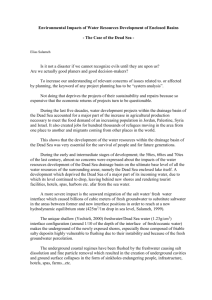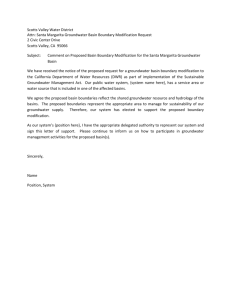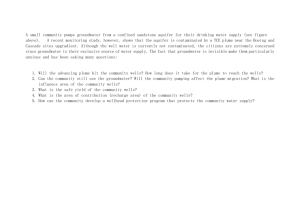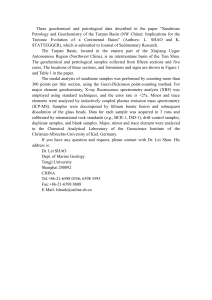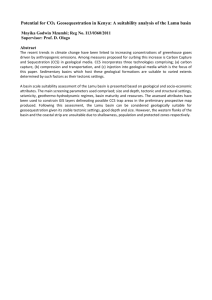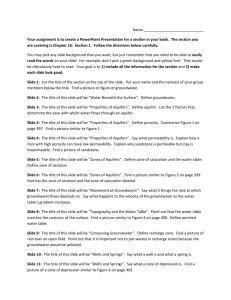PRELIMINARY LOCATION OF THE GROUNDWATER WELLS USING GIS TECHNIQUES:
advertisement
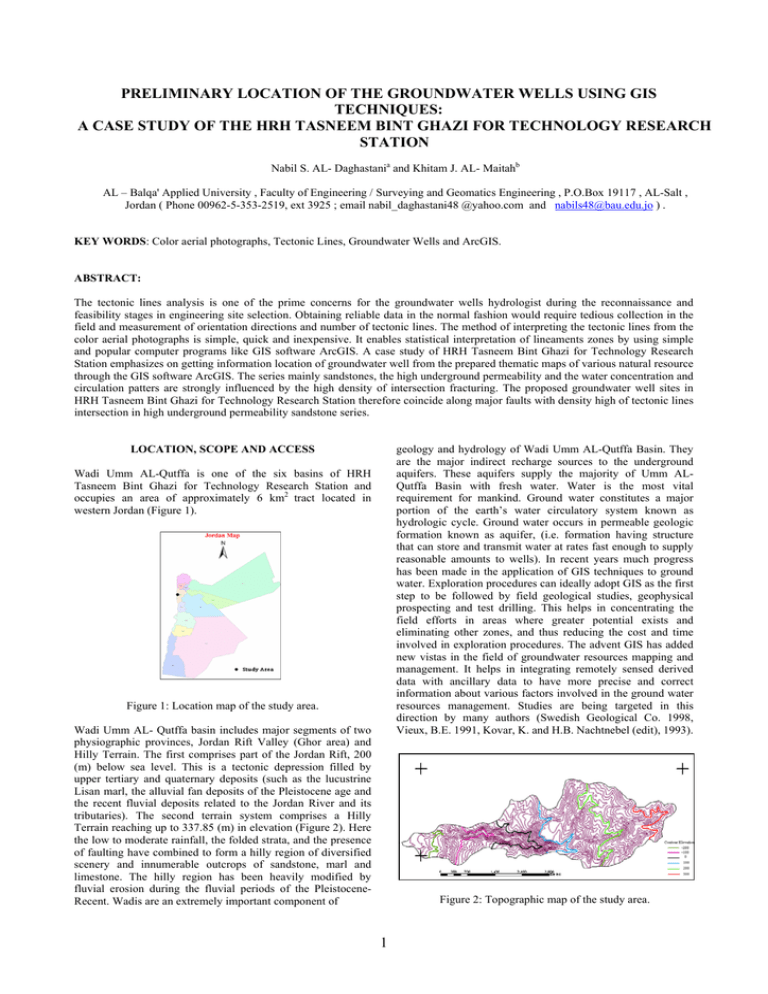
PRELIMINARY LOCATION OF THE GROUNDWATER WELLS USING GIS TECHNIQUES: A CASE STUDY OF THE HRH TASNEEM BINT GHAZI FOR TECHNOLOGY RESEARCH STATION Nabil S. AL- Daghastania and Khitam J. AL- Maitahb AL – Balqa' Applied University , Faculty of Engineering / Surveying and Geomatics Engineering , P.O.Box 19117 , AL-Salt , Jordan ( Phone 00962-5-353-2519, ext 3925 ; email nabil_daghastani48 @yahoo.com and nabils48@bau.edu.jo ) . KEY WORDS: Color aerial photographs, Tectonic Lines, Groundwater Wells and ArcGIS. ABSTRACT: The tectonic lines analysis is one of the prime concerns for the groundwater wells hydrologist during the reconnaissance and feasibility stages in engineering site selection. Obtaining reliable data in the normal fashion would require tedious collection in the field and measurement of orientation directions and number of tectonic lines. The method of interpreting the tectonic lines from the color aerial photographs is simple, quick and inexpensive. It enables statistical interpretation of lineaments zones by using simple and popular computer programs like GIS software ArcGIS. A case study of HRH Tasneem Bint Ghazi for Technology Research Station emphasizes on getting information location of groundwater well from the prepared thematic maps of various natural resource through the GIS software ArcGIS. The series mainly sandstones, the high underground permeability and the water concentration and circulation patters are strongly influenced by the high density of intersection fracturing. The proposed groundwater well sites in HRH Tasneem Bint Ghazi for Technology Research Station therefore coincide along major faults with density high of tectonic lines intersection in high underground permeability sandstone series. geology and hydrology of Wadi Umm AL-Qutffa Basin. They are the major indirect recharge sources to the underground aquifers. These aquifers supply the majority of Umm ALQutffa Basin with fresh water. Water is the most vital requirement for mankind. Ground water constitutes a major portion of the earth’s water circulatory system known as hydrologic cycle. Ground water occurs in permeable geologic formation known as aquifer, (i.e. formation having structure that can store and transmit water at rates fast enough to supply reasonable amounts to wells). In recent years much progress has been made in the application of GIS techniques to ground water. Exploration procedures can ideally adopt GIS as the first step to be followed by field geological studies, geophysical prospecting and test drilling. This helps in concentrating the field efforts in areas where greater potential exists and eliminating other zones, and thus reducing the cost and time involved in exploration procedures. The advent GIS has added new vistas in the field of groundwater resources mapping and management. It helps in integrating remotely sensed derived data with ancillary data to have more precise and correct information about various factors involved in the ground water resources management. Studies are being targeted in this direction by many authors (Swedish Geological Co. 1998, Vieux, B.E. 1991, Kovar, K. and H.B. Nachtnebel (edit), 1993). LOCATION, SCOPE AND ACCESS Wadi Umm AL-Qutffa is one of the six basins of HRH Tasneem Bint Ghazi for Technology Research Station and occupies an area of approximately 6 km2 tract located in western Jordan (Figure 1). Figure 1: Location map of the study area. Wadi Umm AL- Qutffa basin includes major segments of two physiographic provinces, Jordan Rift Valley (Ghor area) and Hilly Terrain. The first comprises part of the Jordan Rift, 200 (m) below sea level. This is a tectonic depression filled by upper tertiary and quaternary deposits (such as the lucustrine Lisan marl, the alluvial fan deposits of the Pleistocene age and the recent fluvial deposits related to the Jordan River and its tributaries). The second terrain system comprises a Hilly Terrain reaching up to 337.85 (m) in elevation (Figure 2). Here the low to moderate rainfall, the folded strata, and the presence of faulting have combined to form a hilly region of diversified scenery and innumerable outcrops of sandstone, marl and limestone. The hilly region has been heavily modified by fluvial erosion during the fluvial periods of the PleistoceneRecent. Wadis are an extremely important component of Figure 2: Topographic map of the study area. 1 sources are translated into the thematic maps by the methods of: Visual interpretation. Classification. Manipulation. Integration. Editing and Analysis. The data translated into thematic maps employ the GIS software ArcGIS. The multi layer thematic maps generate necessary information to provide detail insight to make sitespecific decisions. In this study, color aerial photographs data plays a vital role in the generation of the overlays. JUSTIFICATION FOR CHOICE OF HRH TASNEEM BINT GHAZI FOR TECHNOLOGY RESEARCH STATION The study area possesses a broad range of the surface conditions and has economic problems typical of the those which occur throughout the Jordan Rift Valley and Hilly Terrain such as : severe soil erosion, poor and thin soil, masswasting, vegetation sparse and rare surface water, consequently results in this area should have a wider applicability. The area is backward and underdeveloped. The irrigation potential is heavily underutilizes, with only one groundwater well project. This study shall prepare a detailed environmental impact analysis of proposed groundwater wells and irrigation management plan in the Wadi Umm AL- Qutffa Basin. Therefore, it attempts to asses the present problems of the area and provides suggestive measurement for the irrigation improvement of Wadi Umm AL- Qutffa Basin after the construction of the proposed groundwater wells. Various information layers were integrated through GIS software ArcGIS using overlay methods. Suitable site selection of the proposed groundwater wells using the ArcGIS has been performed. TOPOGRAPHIC MAP In order to register all the thematic maps used in this study we needed to digitize a topographic map at (1:5,000) scale unit by using the following steps as illustrated below: 1. Scanning the topographic map at a 150 dpi resolution level using a CONTEX scanner, and saving it as JPEG image. 2. Exporting the saved image to the AutoCAD software where it was aligned and its scale was justified. 3. Implementing a digitization process to give the contour lines real coordinates. 4. After preparing all the steps above the layers were exported to the Arc/Workstation software where the data were processed and edited. 5. Importing the edited layers by the Arc/Info where they were registered and projection defined on coverage files by using the four registration points surrounding the whole region which appear on the topographic map and on most of the thematic maps used in this study. 6. Defining the contour lines by entering an attribute called elevation. 7. Obtaining the final layer called the topographic map of the study area (Figure 2). STATEMENT OF OBJECTIVES The study has three major objectives: 1. To generate thematic maps of various natural resources. 2. To integrate the thematic maps through the GIS software ArcGIS. 3. To define the location of the proposed groundwater wells in the study area. METHODOLOGY The major goal of this study is to develop a viable methodology for producing GIS data model for preliminary location of groundwater wells, using ArcGIS. The approach adopted in this study has therefore the following steps as illustrated in (Figure 3) DRAINAGE PERIMETER OF UMM AL-QUTFFA BASIN The fundamental unit of virtually all watershed and fluvial investigations is the drainage basin (catchment or watershed) is a finite area whose runoff is channeled through a single outlet (Zavoianu, I., 1985). In its simplest form, a drainage basin is an area that funnels all runoff to the mouth of Wadi Umm AlQutffa Basin. Drainage perimeter of Umm Al-Qutffa Basin was delineated on two topographic maps at scale (1:5,000) by tracing their perimeters or drainage divides. A drainage divide is simply a ridgeline on either side of which water flows to different streams (Jarvis, R. S., 1977). Therefore we can begin drawing our perimeter line by tracing its crest. Ridges are most easily recognized as a series of bent contour lines which are apex point downhill (Figure 4). Figure 3: Flow chart illustrating the methodology. DATA INPUT This study is carried out by combining the features of color aerial photography, topographic sheets and secondary maps data to produce the necessary information layers of natural resources. The input data resulted all of the above diverse Figure 4: Sample of the water divide line. 2 Choosing the correct ridge is simply a matter of determining which ridge sheds water into the Umm Al-Qutffa Basin (Figure 5). Jordanian Geographic Center. Controlled large-scale mosaics in conjunction with Landsat TM imagery were used to provide a broad uniform picture of the study area and guide interpretation during the course of photo mapping. Preliminary analysis of air-photograph used Lica ST4- stereoscope, with higher magnification used on the instrument to elucidate detail. The interpretation of air-photos was carried out using stereo models between the match lines. During the initial interpretation, drainage networks were transferred to topographic map of 1:5,000 scales by using a Zoom Transfer Scope (Drust). Following the technique devised by Strahler (1975), a detailed drainage patterns map of the study area was compiled (Figure 7). Huge canyons are visible due to the strong backscatter from their steep walls, which helps highlight these features. Wadis are an extremely important component of geology and hydrogeology of the region. They are the major indirect recharge sources to the underground aquifers. These aquifers supply the majority of Umm Al – Qutffa Basin fresh water. The main valleys in the Umm Al-Qutffa Basin flows in incised meanders and forming “V” shaped valleys with steep sides. The entire basin has a rectangular and trellis pattern of drainage depicting the influence of structures on the drainage development, and the major valleys with its surface flow running into west direction (Figure 7). Figure 5: Drainage perimeter of Umm AL_Qutffa Basin. REGISTRATION POINTS The thematic layers (i.e., Data input) must be georeferenced and the projection must be indicated; therefore, we select common points with known locations on the ground and on the map in GIS software. These ground control points must be at least four well distributed on the study area (Table 1). Parameter Reference Datum Central Meridian Latitude of Origin False Easting False Northing Scale factor Value European Datum 1950. (ED50) 37:00:00.0 d:m:s 00:00:00.0 d:m:s 500,000 m -3,000,000 m 0.9998 Table 1: JTM Parameters. Figure 7: Drainage pattern map of Umm AL_Qutffa Basin. The map projection is the Jordanian Transverse Mercator (JTM) and the four control points are overlaid in (Figure 5) is illustrated in (Figure 6). BEDDING PLANES Determination of the structural grain of the Umm Al-Qutffa Basin was heavily depending on the aerial photo-interpretation to delineate and trace bedding planes as much as possible, in order to analyze and interpret the structural grain of the study area as illustrated in (Figure 8). Figure 6: Drainage perimeter of Umm AL_Qutffa Basin with four controls points. DRAINAGE PATTERNS Aerial photographs present a complete map, as well as a three dimensional model of the area covered. For many purposes this is quite satisfactory as the trained human brain is a highly sophisticated and effective image-analysis system, performing tasks which machines are often incapable of undertaking. Normal color prints of the study area were obtained from Royal Figure 8: Bedding planes in Umm AL_Qutffa Basin. Noting the differential weathering between sandstone, claystone, limestone and the structural attitude (i.e., steep, moderate and gentle) of bedding planes plays a major role in 3 recognition and delineation of the bedding planes and the structural grain of the study area. Therefore, the area seems to be made up mostly of layered sedimentary strata that consist of Ramla and Hamam Sandstone Formations which are tilted moderately westward. There are also local folding rocks that consist of Kurnub Sandstone Formation illustrate this phenomena (Khitam et. al., 2003). Kurnub Sandstone Formation (Early CRETACEOUS): The Kurnub Sandstone Formation attains almost a thickness (200-300 m) and can be subdivided into eight units: 1, 3, 5 and 7 consist typically of mega cross-bedded, very coarse and pebbly, massive multistory bodies of porous, pink quartz arenite. Fining-up cycles and channels are typical. Units 2 and 4 consist mostly of thin beds of horizontally bedded paige-redfine-grained sandstone, siltstone and occasionally clay. Glauconitic sandstone is often present. Alunite is common in both units 4 and 5 as small balls and thin beds. These beds are often fossilifreous (unit 4). Units 6 and 8 consist of dolomite, dolomite-cemented sandstone and glauconitic sandstone with fossils and trace fossils. From the geological cross section (Figure 10) the study area has two main aquifers bearing high porosity and permeability. LITHOLOGY Differential weathering and features related to bedrock lithology and structural attitude of bedding planes are in stark contrast and plays a major role in the recognition and delineation of the mapable units within Ramla Sandstone, Hamam Sandstone and Kurnub Sandstone Formations. All the formations exposed in the study area are sedimentary rocks (Figure 9) and almost all are deposited in a complex peritidal environment, mixed carbonate-siliclastic shoreline sequence, swampy to lagoon and marine (subtidal to intertidal), (Basem et.al., 1998). 1. Kurnub Sandstone Formation (200-300 m). 2. Hamam and Ramla Sandstone Formations (160 m). GEOLOGICAL CROSS SECTION From the geological cross section (Figure 10) shows that all the Formations are tilted moderately westward with local folding. The sandstone series are intercepted by several numbers of deep selected normal faults. In Figure (10), the groundwater flow generally oriented westward. Figure 9: Lithology mapable units in Umm AL_Qutffa Basin. The oldest to youngest Formations known are as follows: Figure 10: Geological cross section in Umm AL_Qutffa Basin. Ramla Sandstone Formation (Middle JURASSIC): TECTONIC LINES In all its outcrops, this siliclastic formation attains almost a thickness (80 m) and similar facies sequences. These commonly start at the base with cross-bedded sandstones (Facies A) and grade upwards to very thinly, horizontally bedded sandstones often ripple cross-laminated (Facies B), which, in turn, grade upwards to siltstone and claystone (Facies C). Tectonic lines are usually faults, lineaments and joints. These lines to stand out because of differential erosion, which leaves the more resistant layers or ridges rising above the more easily eroded unites or can be picked out as lines (appearing as such or evident because of contrast in terrain or ground cover on either side) in color aerial photographs. The tectonic lines map is illustrated in Figure (11). Hamam Sandstone Formation (Middle JURASSIC): In the study area, Hamam Sandstone Formation attains almost a thickness (55-60 m) and can be subdivided into nine unites: 1,3,5 and 8 consist typically of fossilifreous very hard limestone, bedded fossilifreous limestone, highly fossilifreous micritic limestone and grey, thin bedded dolomite. Unites 2,4,6 and 7 consist typically of medium-grained, bedded sandstone, medium-grained dolomite-cemented sandstone, massive sandstone beds and fine to medium grained, thin bedded ferruginous sandstone, unit 9 consists typically of black, laminated noncalcareous clay. Figure 11: Tectonic lines in Umm AL_Qutffa Basin. 4 As illustrated in Figure (12) and Table (2) the rose diagram showing the directions of lineaments with unequal prevalence, revealed by normal color aerial photographs in Wadi Umm ALQutffa Basin. It was found that the main three trends of the lineaments are: 1. N 50◦ E – S 50◦ W; which announces the trace of the general orientation of shear joints and fault patterns in the underlying bedrock. 2. N 80◦ E – S 80◦ W; which announces the trace of the general orientation of tension dip joints in the underlying bedrock. 3. N 70◦ W – S 70◦ E; which announces the trace of the general orientation of shear joints in the underlying bedrock. Stream direction N 0-10 E RECOGNITION OF FAULTS A fault is a fracture in the Earth’s crust along which there has been some relative movement of rock on one side against the other side. This appears as some form of displacement or offset of once contiguous units. We recognize Faults by various criteria: 1. Layers of different type and ages of rock unite sit side by side. 2. Abrupt topographic discontinuities of landforms. 3. Depressions along the fault trace (broken rock is more easily eroded). 4. Scarps or cliffs. 5. Sudden shifts of drainage covers. 6. Abrupt changes in vegetation patterns. 11 4.641 Rose diagram scale 1cm=2% 2.321 011-20 11 4.641 2.321 GRID 100*100m 21-30 14 5.907 2.954 31-40 11 4.641 2.321 41-50 25 10.549 5.274 The final tectonic lines map (Figure 11) is overlapped with (100X100) m grid cell using ArcGIS, ArcView 8.3, as illustrated in (Figure 13). 51-60 18 7.595 3.797 61-70 9 3.797 1.899 4.852 Number % 71-80 23 9.705 81-E 19 8.017 4.008 N 0-10 W 6 2.532 1.266 011-20 5 2.110 1.055 21-30 9 3.797 1.899 31-40 11 4.641 2.321 41-50 12 5.063 2.532 51-60 13 5.485 2.743 61-70 15 6.329 3.165 71-80 12 5.063 2.532 81-W 13 5.485 2.743 237 100.000 Figure 13: Tectonic lines map with grid cell (100m x 100m). NUMBER OF OCCURRENCE OF TECTONIC LINES PER GRID CELL Table 2: Tectonic lines data analysis in Wadi Umm Qutffa basin. The number of tectonic lines in each grid cell is counted by using ArcGIS, Arcview, and represented by points in different colors, each color represent the number of tectonic lines in each grid cell as illustrated in (Figure 14). N E W S Figure 12: Rose diagram showing the directions of tectonic lines. (There are three major trends: N50E-S50W, N80E- S80W, and N70W-S70E). Figure 14: Number of tectonic lines in each grid cell. 5 DENSITY CONTOUR FOR TECTONIC LINES Fault By using the ArcGIS software we can highlight the grid cells that bearing the highest density occurrence of tectonic lines, as illustrated in (Figure 15). A B Figure 15: Density contour for tectonic line. High tectonic lines contour density that means high circulation and presence of internal movement of the groundwater. Therefore, the probability of getting the groundwater will increase in the grid cells having high tectonic lines. Figure 15 was transposed onto a Figure 13 in order to help delineation of the preliminary locations of the groundwater wells as illustrated in Figure (16) and Tables (3 and 4). C D E Location of groundwater wells site. X Y 1 372900.6 551033.7 2 372615.8 550904.2 3 372408.6 550731.6 4 372072.1 550636.7 5 371821.7 550455.4 6 371588.7 550360.5 1 371692.3 552112.6 2 371580.1 551948.5 3 371493.8 551655.1 4 371355.7 551430.7 5 371165.8 550973.3 6 371010.5 550688.5 1 371174.5 552078.0 2 371019.1 551637.8 3 370734.2 550722.9 1 370302.7 550783.4 2 370138.7 551491.1 3 369905.7 551404.8 4 369733.1 551120.0 1 368878.6 550792.0 2 368645.5 550705.7 3 368378.6 550671.2 4 368119.1 550688.5 Table 3: The proposed locations of water wells in Umm AlQutffa Basin. Surface flow direction Figure 16: The proposed locations of groundwater wells in Umm Al- Qutffa Basin. Locations of the potential groundwater wells. X Y 5 371821.7 550455.4 6 371588.7 550360.5 B 6 371010.5 550688.5 C 3 370734.2 550722.9 2 368645.5 550705.7 3 368378.6 550671.2 4 368119.1 550688.5 Fault A E Table 4: The proposed locations of the potential groundwater wells in Wadi Umm Al-Qutffa Basin 6 RESULTS AND DISCUSSION A preliminary location map of the groundwater wells was produced from color aerial photographs data of 2001 and filed data using GIS techniques. A GIS technique to locate groundwater wells sites on the Wadi Umm Qutffa Basin based on topographic map, catchments area, and drainage patterns, bedding planes, lithology, geological cross section and tectonic lines has identified twenty three possible location groundwater wells sites as illustrated on Figure 16 and Table 3. This information has been used to evaluate the out comes from the GIS and remotely sensed data research method employed in this study. Using the overlay combination method in GIS (i-e major faults, high of tectonic lines intersection, high underground permeability sandstone series and along the maximum surface and subsurface water flow direction), there are seven potential proposed groundwater wells sites as illustrated in blue color in Figure 16 and Table 4. CONCLUSION A methodological approach in conducting a research using GIS was presented selecting location of groundwater sites as a case study. The GIS can be utilized in two ways. First, to input, store, organize and analyze the data available. Secondly, the spatial analysis, visualization and query capabilities of GIS can be employed in selecting the groundwater well sites for a precondition set of criteria. This paper has shown the GIS, can be a powerful tool in planning, managing a research work involving spatial data analysis, particularly in site suitability studies. LIST OF REFERENCES Basem, K.M., and Samier, M., 1998. The Geology of As-Salt Area. Map sheet No (3254111). The Hashemite Kingdom of Jordan Natural Resources Authority, pp: 1- 67, Amman, Jordan. Khitam, J.M.; Yolla, Y.A; Sana, T.B. and Waseem, J.H., 2003. Applications of Aerial Photo-Interpretation GIS Data Model in Dams and Water Wells sites selection, Princess Tasneem Bint Ghazi for Technology Research Station (Unpublished). AlBalqa Applied University, Al-=Salt, Jordan. Jarvis, R.S, 1977. Drainage network analysis. Progress in physical Geography 1: 271-295. Kovar, K. and H.B. Nachtnebel (Edit) 1993. Application of Geographic Information System in hydrology and water resources management, IAHS Publication No. 211. International Association of hydrological Sciences Press, Wallingford. Strahler, A.N., 1975. Physical Geography, Fourth Edition, ch. 27. Swedish Geological Co., 1998. Serowe, Groundwater Resources Evaluation Project. Final Report, August 1998, Stockholm. Vieux, B.E., 1991. Geographic Information Systems and non point source water quality and quantity modeling. Hydrological Processes 5: 101-113. Zavoianu, I, 1985, Morphometry of drainage basins. Institute of Geography, Bunchares, P.238. 7

